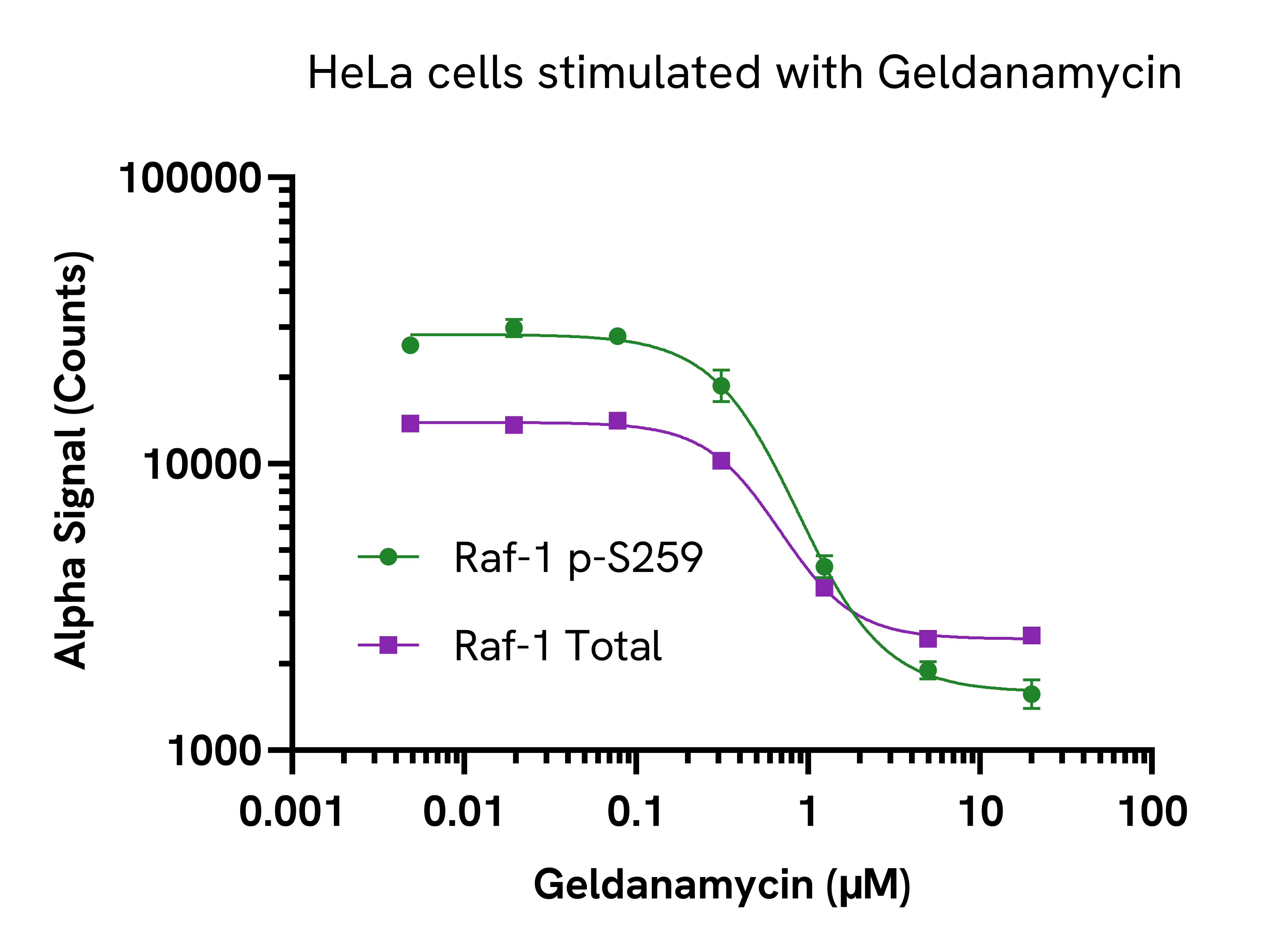

AlphaLISA SureFire Ultra Human and Mouse Phospho-RAF1 (Ser259) Detection Kit, 500 Assay Points
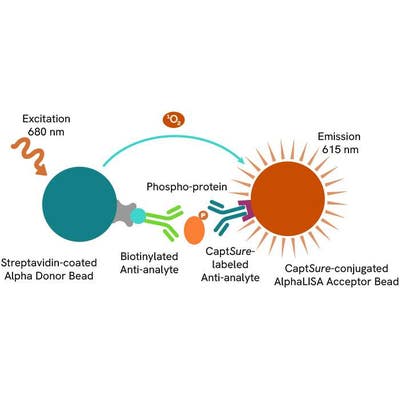

 View All
View All
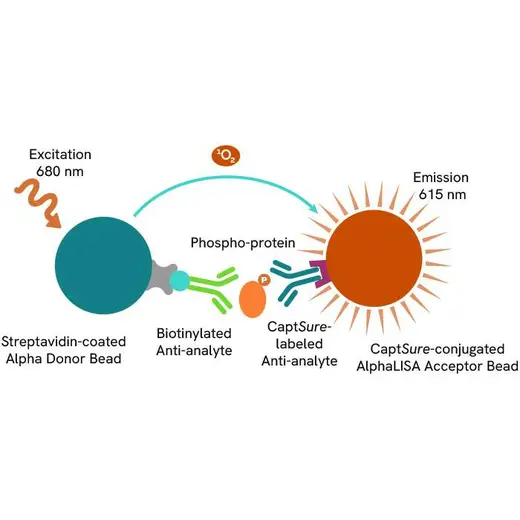



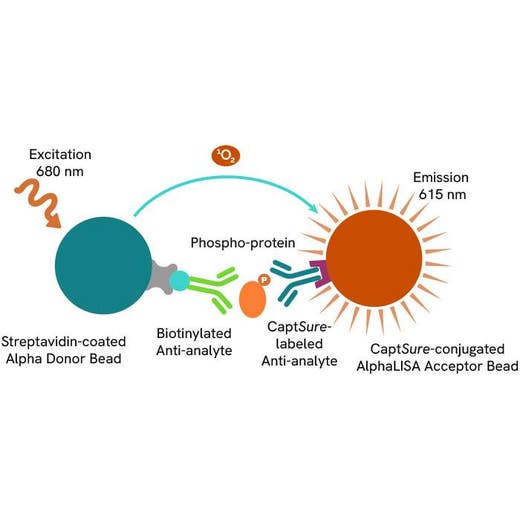



| Feature | Specification |
|---|---|
| Application | 細胞シグナル伝達 |
| Sample Volume | 10 µL |












Product information
Overview
RAF proto-oncogene serine/threonine-protein kinase has numerous aliases, including Raf-1, c-Raf, and proto-oncogene c-RAF. Raf-1 is an enzyme belonging to the subfamily of membrane associated GTPases. Raf-1 is a principal component of the mitogen-activated protein kinase (MAPK) pathway, specifically the ERK1/2 signaling cascade 1. Raf-1 regulates cell growth and division, playing a key role in cell proliferation. It is also involved in cell survival pathways and metabolic processes within cells. This protein is associated with various cancers, including bladder urothelial carcinoma, skin cutaneous melanoma, and uterine corpus endometrial carcinoma.
The AlphaLISA SureFire Ultra Human and Mouse Phospho-Raf-1 (Ser259) Detection Kit is a sandwich immunoassay for the quantitative detection of phospho-Raf-1 in cellular lysates, using Alpha technology.
Formats:
- The HV (high volume) kit contains reagents to run 100 wells in 96-well format, using a 60 μL reaction volume.
- The 500-point kit contains enough reagents to run 500 wells in 384-well format, using a 20 μL reaction volume.
- The 10,000-point kit contains enough reagents to run 10,000 wells in 384-well format, using a 20 μL reaction volume.
- The 50,000-point kit contains enough reagents to run 50,000 wells in 384-well format, using a 20 μL reaction volume.
AlphaLISA SureFire Ultra kits are compatible with:
- Cell and tissue lysates
- Antibody modulators
- Biotherapeutic antibodies
Alpha SureFire kits can be used for:
- Cellular kinase assays
- Receptor activation studies
- High-throughput drug screening
How it works
Phospho-AlphaLISA SureFire Ultra assay principle
The Phospho-AlphaLISA SureFire Ultra assay measures a protein target when phosphorylated at a specific residue.
The assay uses two antibodies which recognize the phospho epitope and a distal epitope on the targeted protein. AlphaLISA assays require two bead types: Acceptor and Donor beads. Acceptor beads are coated with a proprietary CaptSure™ agent to specifically immobilize the assay specific antibody, labeled with a CaptSure tag. Donor beads are coated with streptavidin to capture one of the detection antibodies, which is biotinylated. In the presence of phosphorylated protein, the two antibodies bring the Donor and Acceptor beads in close proximity whereby the singlet oxygen transfers energy to excite the Acceptor bead, allowing the generation of a luminescent Alpha signal. The amount of light emission is directly proportional to the quantity of phosphoprotein present in the sample.
Phospho-AlphaLISA SureFire Ultra two-plate assay protocol
The two-plate protocol involves culturing and treating the cells in a 96-well plate before lysis, then transferring lysates into a 384-well OptiPlate™ plate before the addition of Phospho-AlphaLISA SureFire Ultra detection reagents. This protocol permits the cells viability and confluence to be monitored. In addition, lysates from a single well can be used to measure multiple targets.
Phospho-AlphaLISA SureFire Ultra one-plate assay protocol
Detection of Phosphorylated target protein with AlphaLISA SureFire Ultra reagents can be performed in a single plate used for culturing, treatment, and lysis. No washing steps are required. This HTS designed protocol allows for miniaturization while maintaining AlphaLISA SureFire Ultra quality.
Assay validation
Inhibition of Phospho Raf-1 (Ser259)
HeLa cells were seeded in a 96-well plate(40,000 cells/well) in complete medium, and incubated overnight at 37°C, 5% CO2. The cells were treated for 24 hours with increasing concentrations of Geldanamycin prepared in serum free medium containing 1% FBS.
After treatment, the cells were lysed with 100µL of lysis buffer for 10 minutes at RT with shaking (350 rpm). Raf-1 Phospho (Ser259) and Total levels were evaluated using respective AlphaLISA SureFire Ultra assays. For the detection step, 10 µL of cell lysate(approximately 4,000 cells) were transferred into a 384-well white OptiPlate, followed by 5µL of Acceptor mix and incubated for 1 hour at RT. Finally, 5 µL of Donor mix was then added to each well and incubated for 1 hour at RT in the dark. The plate was read on an Envision Nexus™ using standard AlphaLISA settings.
As expected, Geldanamycin (HSP90 inhibitor, disrupts the Raf-1-HSP90 complex) triggered a dose-dependent decrease in the levels of Raf-1 Phospho (Ser259) and Total.

Assay specificity/selectivity
Selectivity of Phospho Raf-1 (Ser259) assay
Raf-1 or Raf-1 p-S259 peptides were titrated into a fixed dilution of positive control lysate (HeLa cells treated with 200 ng/mL PMA). RAF1 Phospho (Ser259) levels were evaluated by AlphaLISA SureFire Ultra. For the detection step, 10 µL of peptide mix was transferred into a 384-well white OptiPlate, followed by 5 µL of Acceptor mix and incubated for 1 hour at RT. Finally, 5 µL of Donor mix was then added to each well and incubated for 1 hour at RT in the dark. The plate was read on an Envision Nexus using standard AlphaLISA settings.
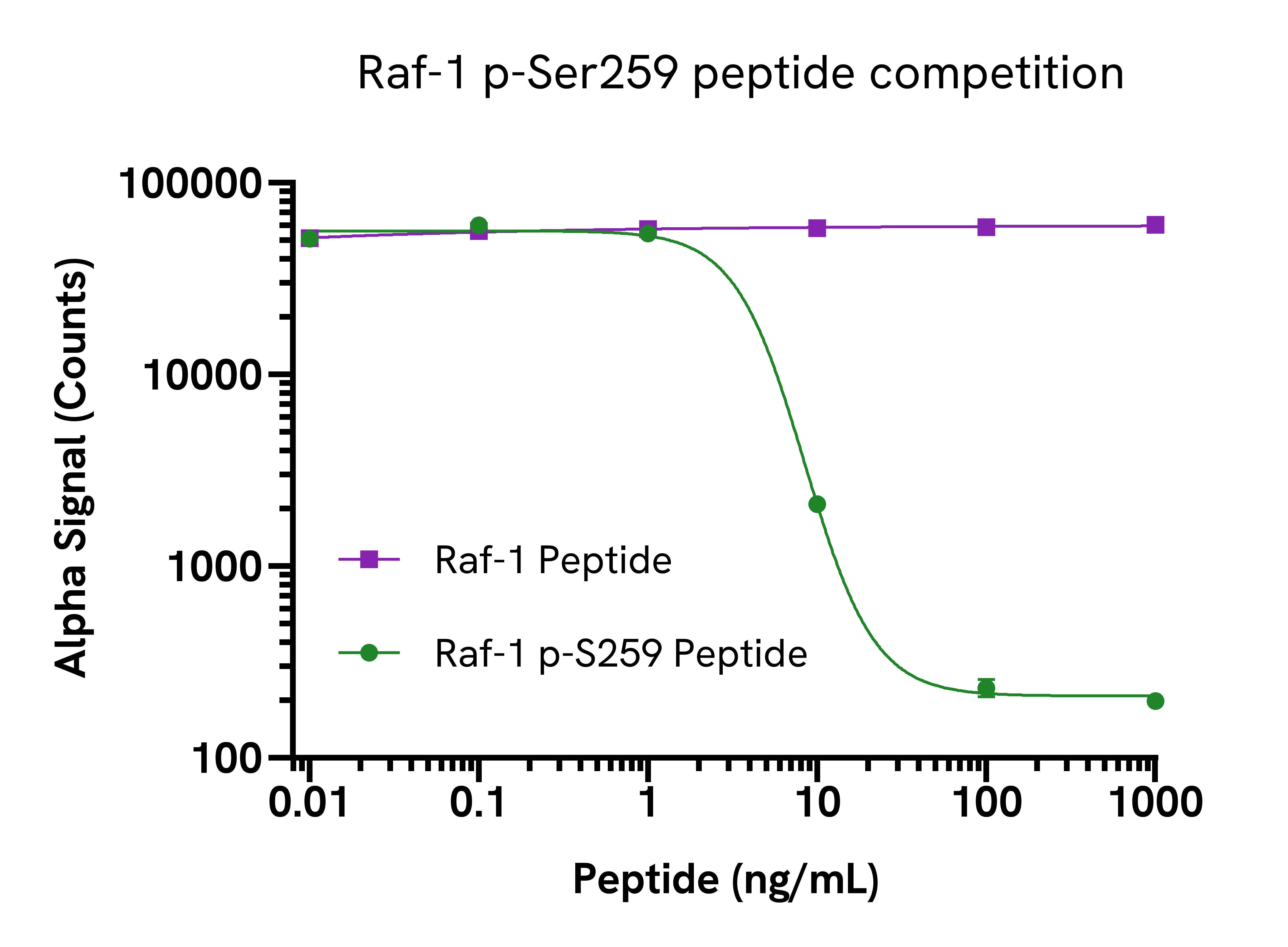
Phospho Raf-1 (Ser259) levels were assessed in HeLa cells (WT) and Raf-1 knockout (KO) HeLa cells. Raf-1 KO cells (Abcam ab264978) and WT-HeLa cells were cultured to confluency in T25 flasks in complete medium at 37°C, 5% CO2.
Each flask was lysed in 2 mL of lysis buffer for 10 minutes at RT with shaking (350 rpm). Phospho Raf-1 (Ser259) levels were then evaluated by AlphaLISA SureFire Ultra. For the detection step, 10 µL of cell lysate was transferred into a 384-well white OptiPlate, followed by 5 µL of Acceptor mix and incubated for 1 hour at RT. Finally, 5 µL of Donor mix was then added to each well and incubated for 1 hour at RT in the dark. The plate was read on an Envision Nexus using standard AlphaLISA settings. As expected, Phospho Raf-1 (Ser259) was detected in the WT-Hela cells but not in the Raf-1 KO cell line.
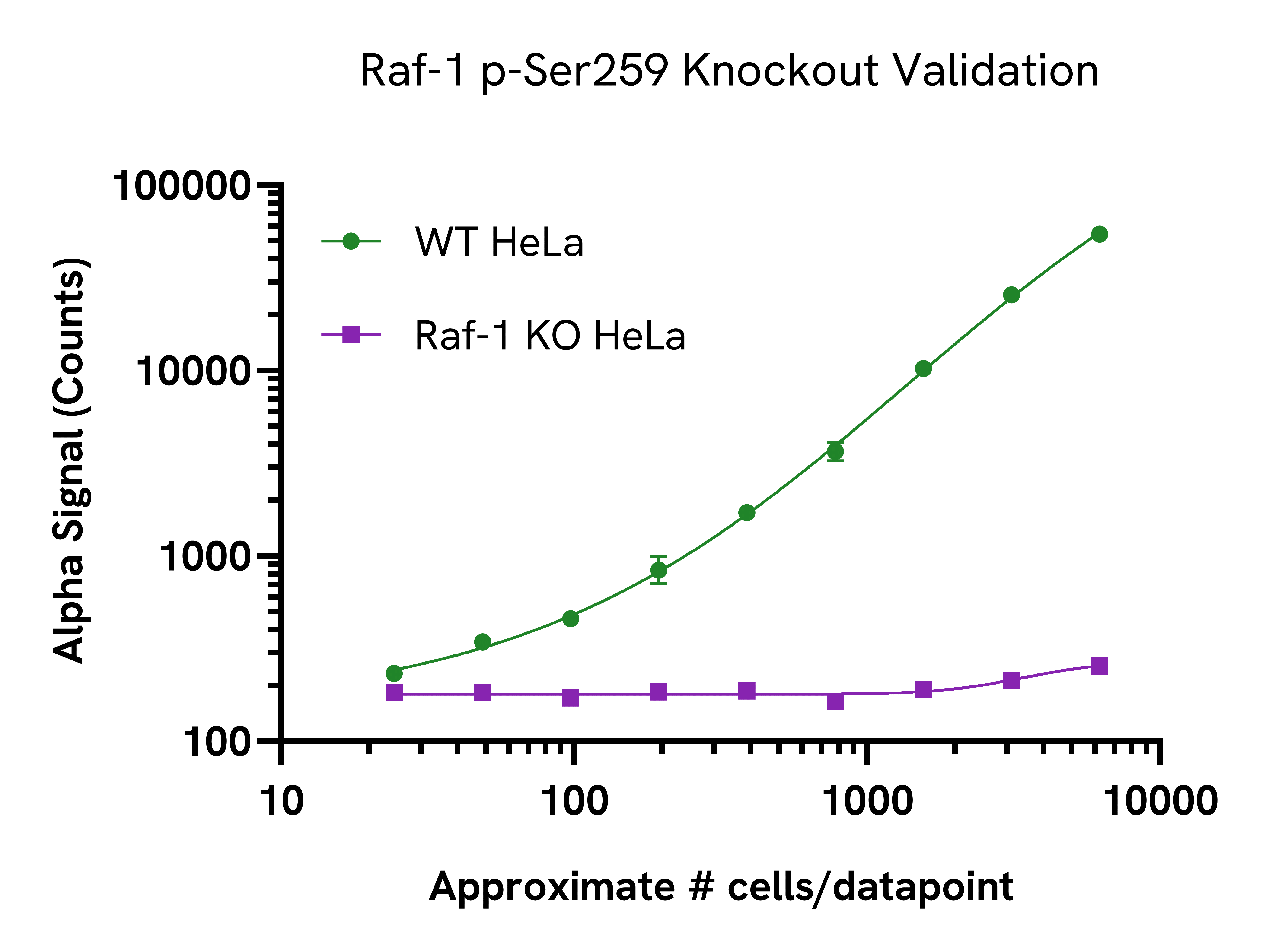
Specifications
| Application |
Cell Signaling
|
|---|---|
| Automation Compatible |
Yes
|
| Brand |
AlphaLISA SureFire Ultra
|
| Detection Modality |
Alpha
|
| Host Species |
Human
Mouse
|
| Lysis Buffer Compatibility |
Lysis Buffer
|
| Molecular Modification |
Phosphorylation
|
| Product Group |
Kit
|
| Sample Volume |
10 µL
|
| Shipping Conditions |
Shipped in Blue Ice
|
| Target |
Raf-1
|
| Target Class |
Phosphoproteins
|
| Target Species |
Human
Mouse
|
| Technology |
Alpha
|
| Therapeutic Area |
Oncology
|
| Unit Size |
500 assay points
|
Video gallery






Resources
Are you looking for resources, click on the resource type to explore further.
Quantifying H3K9ac in Cellular Extracts with AlphaLISA
This technical note gives you details about how AlphaLISA immunodetection...
Quantification of H3K27me3 Levels Using AlphaLISA Technology
In this technical note discover how AlphaLISA™ immunodetection assay...
Unlocking the secrets of epigenetics, our technical not dives into optimizing a DOT1L enzymatic assay
This technical document...
AlphaLISA ™ Detects β2-Microglobulin in Urine with High Sensitivity
When kidney tubular function is impaired, elevated levels of β2...
The definitive guide for setting up a successful AlphaLISA SureFire Ultra assay
Several biological processes are regulated by...
Discover Alpha SureFire® Ultra™ assays, the no-wash cellular kinase assays leveraging Revvity's exclusive bead-based technology...


How can we help you?
We are here to answer your questions.






























